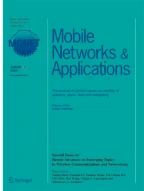Abstract
Wireless mesh networks (WMNs) are being widely accepted as a critical wireless access solution for various applications. Due to minimal mobility in mesh nodes, a backbone topology can be effectively maintained in WMN using a proactive routing protocol. In IEEE 802.11s standard, a tree-based routing (TBR) protocol is adopted as a viable proactive routing protocol for a WMN with user traffic flowing to/from a wired network through a root (i.e., a mesh portal). However, the performance of the TBR protocol degrades rapidly as the user traffic becomes dominated by intra-mesh traffic. The reason is that the routing path through the root even for intra-mesh traffic unnecessarily overloads the root. Furthermore, the TBR performance becomes more severe when the network size of WMN is large, which could lead to the huge amount of intra-mesh traffic towards the root. To overcome these problems, we propose a new routing mechanism, root driven routing (RDR) protocol, for the root to quickly determine the best-metric route for any source-destination pair of intra-mesh traffic. For inter-mesh traffic, the original TBR protocol is employed. Thus, the hybrid centralized routing protocol that combines TBR and RDR and is adaptive to all traffic scenarios. Our simulation results reveal that the proposed RDR protocol outperforms the TBR protocol with much lower average end-to-end delay and much higher packet delivery ratio for intra-mesh traffic. The simulation results also provide some insight into the right tradeoff between the TBR protocol and the RDR protocol to achieve the best performance of the hybrid centralized routing protocol for WMNs.
Similar content being viewed by others
References
Raniwala A, Chiueh TC (2005) Architecture and algorithms for an IEEE 802.11-based multi-channel wireless mesh network. In: Proc. IEEE INFOCOM conf. IEEE, Piscataway, pp 2223–2234
IEEE (2007) Amendment: Mesh networking. IEEE P802.11s/D1.06. IEEE, Piscataway
Akyildiz IF, Wang X, Wang W (2005) Wireless mesh network: a survey. Comput Netw 47(4):445–487
IEEE (1999) Part II: Wireless LAN medium access control (MAC) and physical layer (PHY) specifications, ANSI/IEEE Standard 802.11-1999. IEEE, Piscataway
Juttner A, Magi A (2005) Tree based broadcast in ad hoc networks. Mob Netw Appl 10(5):753–762
Chlamtac I, Kutten S (1987) Tree-based broadcasting in multihop radio networks. IEEE Trans Comput C-36(10):1209–1223
Ogier R, Templin F, Lewis M (2004) Topology dissemination based on reverse-path forwarding (TBRPF). RFC 3684. IETF, Fremont
Dalal YK, Metcalfe RM (1978) Reverse path forwarding of broadcast packets. Commun ACM 21:1040–1048
Royer E, Perkins C (1999) Multicast operation of the ad hoc on-demand distance vector routing protocol. In: Proc. mobicom conf., Seattle, 19 August 1999
Perkins C, Royer E, Das S (2003) Ad hoc on-demand distance vector (AODV) routing. RFC 3561. IETF, Fremont
IEEE (2004) Medium access control (MAC) bridges, IEEE Standard 802.1D-2004. IEEE, Piscataway
OPNET (2008) OPNET Simulator. http://www.opnet.com/
Szigeti T, Hattingh C (2005) End-to-end QoS network design: quality of service in LANs, WANs, and VPNs. Cisco, Indianapolis
Author information
Authors and Affiliations
Corresponding author
Rights and permissions
About this article
Cite this article
Lim, A.O., Wang, X., Kado, Y. et al. A Hybrid Centralized Routing Protocol for 802.11s WMNs. Mobile Netw Appl 13, 117–131 (2008). https://doi.org/10.1007/s11036-008-0038-4
Received:
Accepted:
Published:
Issue Date:
DOI: https://doi.org/10.1007/s11036-008-0038-4
